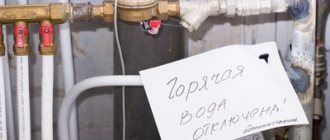Legislative basis for the formation of heating fees
Currently, the procedure for determining the amount of payment for provided heat is based on Resolution 354 of the Government of the Russian Federation[1]. The adoption of this standard took place in 2012, and since then the main version of the document has undergone various adjustments.
Changes were repeatedly made to the calculation methodology itself. The concept of “general house heating needs” was introduced, which was calculated separately from the heating of residential premises. But in 2013, the heating service was combined into a single utility service, without separation according to the purpose of the room.
Improvements are ongoing to this day; in 2021, new formulas were introduced to calculate the amount presented for payment by the consumer. And in the current period, calculations are carried out precisely according to these criteria and using a new procedure for generating payments.
How can Ukrainians check the correctness of heat cost calculations: calculation formula
Heating tariffs in Ukraine are calculated using the following formula:
TARIFF = ZPS + ZPP + PP / OR te, where
- ZPS – full cost costs
- ZPP – costs to cover losses
- PP – planned profit
- OR te – volume of sales of thermal energy
The formula at first glance seems complicated, but ordinary consumers should understand the main principle of tariff formation: the ratio of the amount of costs to the volume of heat supply.
Full cost costs consist of:
- Fuel costs – 83%
- Labor costs – 7%
- Taxes – 5%
- Equipment depreciation – 2%
- Repair and maintenance work – 2%
- Planned profit – 1%
The volume of heat energy sales is established in accordance with the requirements of industry standards. The same standards establish the specific weight of permissible heat supply losses.
As of October 2021, the weighted average tariff for thermal energy for the population in the 2019/20 heating season is 1654.41 UAH/Gcal.
The economically justified cost is 1154.30 UAH/Gcal.
| Heat supply company | Tariff with metering devices, UAH. with VAT for 1 Gcal | Tariff without metering devices, UAH. with VAT per 1 m 2 |
| PJSC "Kyivenergo" | 1654,41 | 38,50 |
| Euro-Reconstruction LLC | 1341,53 | 35,63 |
| Heat supply company | Tariff with metering devices, UAH. with VAT for 1 Gcal | Tariff without metering devices, UAH. with VAT per 1 m 2 |
| CP "Brovaryteplovodoenergiya" | 1479,01 | 35,01 |
| KP SMR "Belotserkovteploset" | 1530,83 | 33,66 |
| PJSC " | 632,48 | 14,36 |
| Heat supply company | Tariff with metering devices, UAH. with VAT for 1 Gcal | Tariff without metering devices, UAH. with VAT per 1 m 2 |
| KP "Heat supply of the city of Odessa" | 1229,20* | 30,76* |
| Heat supply company | Tariff with metering devices, UAH. with VAT for 1 Gcal | Tariff without metering devices, UAH. with VAT per 1 m 2 |
| LLC NPP "Energia-Novoyavorovsk" | 1244,31* | 29,13* |
| LLC "Energy-Novy Rozdol" | 1247,34* | 32,59* |
| LCP "Zheleznodorozhteploenergo" | 1160,06 | 25,38 |
| LMKP "Lvovteploenergo" | 1205,77 | 26,40 |
1. During what period does payment for heating take place in a specific region of the Russian Federation: during the heating period or during the calendar year, that is, 12 months .
2. The presence or absence of a common house (collective) heat meter in an apartment building.
3. The method of equipping residential premises (apartments) and non-residential premises (if they are in the house) with individual metering devices for thermal energy (heating) - presence or absence.
IPU - individual metering device;
ODPU - a common building (collective) metering device installed in an apartment building;
Residential premises in an apartment building - apartment;
Non-residential premises in an apartment building are various shops, offices, parking spaces, underground garages and parking lots, and so on, located in an apartment building .
The calculation methods and examples presented below provide an explanation of the procedure for calculating the amount of heating fees for residential premises (apartments) located in apartment buildings that have centralized systems for supplying heat energy - a centralized heat supply system .
Calculation No. 1 The amount of payment for heating in a residential building (apartment), in an apartment building the thermal energy budget has not been established ; payment for heating is carried out during the heating period (formula 2(3)) . Read about the procedure and example of calculation →
Calculation No. 2 The amount of payment for heating in a residential premises (apartment), the ODPU in an apartment building has not been established; the ODPU for thermal energy is not established ; payment for heating is carried out during the calendar year (12 months) (formula 2(4)) . Read about the procedure and example of calculation →
Calculation No. 3 The amount of payment for heating in a residential premises (apartment) , in an apartment building an ODPU is installed , there are no individual heat meters in all residential and non-residential premises , payment for heating is carried out during the heating period (formula 3) . Read about the procedure and example of calculation →
Calculation No. 3-1 The amount of payment for heating in a residential premises (apartment) an ODPU is installed in an apartment building , there are no individual heat energy meters in all residential and non-residential premises , payment for heating is carried out evenly throughout the calendar year (12 months) (formula 3) . Read about the procedure and example of calculation →
Calculation No. 4 The amount of payment for heating in a residential building (apartment) , an ODPU is installed in an apartment building , individual meters are not installed in all premises of the apartment building , payment for heating is carried out during the heating period (formula 3(1)) . Read about the procedure and example of calculation →
Calculation No. 4-1 Amount of payment for heating in a residential building (apartment) , an ODPU is installed in an apartment building , individual meters are not installed in all premises of an apartment building , payment for heating is carried out during the calendar year (12 months) (formula 3(1) ) . Read about the procedure and example of calculation →
Calculation No. 5 The amount of payment for heating in a residential building (apartment) , an ODPU is installed in an apartment building , individual metering devices are installed in all residential and non-residential premises of an apartment building (formula 3(3)) . Read about the procedure and example of calculation →
- Non-residential premises and common areas in an apartment building
- What are general house needs (CHN)?
- Payments are sent, but there is no heat!
- About the number of residents of an apartment building
- On the results of licensing management companies
Factors influencing the formation of payment in an apartment building
According to the law, the following factors influence the formation of the amount received for payment for the service provided:
- Type of heat supply system depending on the source of heat supply. Since the classification system can be centralized or decentralized, the formation of the payment system depends on this factor.
- Availability of thermal energy consumption metering devices regardless of purpose. That is, the calculations provided for payment include both general house mechanisms and individual heat meters.
- Method for calculating fees for the operation of heat supply. The method means presenting bills year-round or only during the heating season. The heating payment method is adopted at the regional level. Heating companies in each region are authorized to make charges based on consumption, excluding summer time, but within the framework of regional regulations.
- Availability of technical capability to install thermal energy IPU.
Based on the existing factors that influence the formation of the amounts presented for reimbursement, several options can be identified for calculating the payment for heat supply.
Accrual algorithm No. 1
The main components of the calculation are a centralized heating system, no meters, and a seasonal payment method.
According to the Rules for Forming the Cost of Heat Supply, which are approved by Resolution No. 354, the calculation is made using the following formula:
Ppayments = Stotal * N * T,
Where:
Stotal – the total area of the occupied dwelling, m2.
N – heat consumption according to the standard, Gcal/m2. This indicator is developed at the local level by authorized energy commissions. Adopted by local governments and subject to revision once every 3 years.
T – regional tariff for heat energy, rubles. In the case of several housing and communal services organizations for the supply of heat, this indicator may vary between companies.
Attention! If it is technically possible to provide an apartment building with a heat resource meter, an additional load is introduced into the formula in the form of Kcp - an increasing coefficient, the value of which has been included in the calculations since 2016. From January 1, 2021, the coefficient for any method of calculation without meters is 1.5.
Accrual algorithm No. 2
The main components of the calculation are that the heating system is centralized, there are no metering devices, the calculation is made evenly throughout the year, including in the summer.
Under these conditions, a different formula of the Rules is applied to the calculation, namely formula No. 2-1, and the fee is calculated as follows:
Rolats = Stotal * (N *K) * T,
Where:
Stotal – total square footage of the apartment, m2.
N – indicator of the heating service consumption rate, Gcal/m2.
K – coefficient indicating the frequency of payment for the provided heat. It is taken as the ratio of the number of months of the actual heating season, including incomplete ones, to the year-round period. For example, heating in the region lasted 7 months, the coefficient is calculated as 7/12=0.583. The definition of the coefficient was adopted by Government Decree No. 857.
T – regional tariff for covering heat supply services in rubles.
Accrual algorithm No. 3
Modern new buildings in most cases receive an uninterrupted supply of heat using autonomous IHP. With such a heating source, independent production of coolant is provided using equipment that is the common property of all MRR owners.
The amount of payment for this type of coolant generation is determined by the following formula:
P=∑(V*S/S*T)
Where
V is the amount of utility resource that was spent on the production of coolant. These include heat energy, electricity, cold water. According to Resolution No. 1498, the average volumes of resources used for the previous calendar year are taken into account.
S – General square footage of the calculated dwelling.
S – Total area of all premises in the Moscow Railway.
T – The price of each utility resource used for the production of coolant in the ITP.
Ukrainians will be forced to pay for heating and hot water all year round
Citizens who have installed individual metering devices have the right to make payments based on the amount of heat received, regardless of the installation or absence of meters in other apartments.
Calculation of heating payments in 2021
Heating in an apartment building is calculated based on several conditions:
- absence or presence of a common IPU for MCD;
- availability of individual metering controllers in the premises.
An additional condition is year-round payment or only in winter.
A gigacalorie in heating is considered to be 1 billion calories. The last unit is calculated as the instrument required to heat 1 g of water to 1° C at normal atmospheric pressure. In 2021, for heating 1 sq. m of area requires 0.9342 Gcal for one month.
This unit has been used by the Ministry of Fuel since the mid-1990s, and has varied upwards and downwards. Taking the individual meter readings for a specific month of the year and multiplying them by the existing tariff, you get the amount payable.
For year-round payment without installed apartment and collective meters, contributions must be calculated using the following expression:
P=S×(N×K)×T,
Where:
- K - equal to the frequency of depositing money within one calendar year.
The coefficient is calculated as follows:
K=(months of the heating season)/12.
In the absence of a general measuring apparatus confirmed by a technical act, the formula is supplemented with an increasing value of 1.5.
P=S×1.5(N×K)×T.
The presented methodology is designed for buildings with a collective controller and some apartments equipped with measuring devices. The readings of individual metering devices are not taken into account here, because the resource is provided for heating the building as a whole.
P=V×(S/Stotal)×T,
Where:
- P – monthly fee;
- S – area of a single apartment in m2;
- Stotal – total footage of all heated rooms of the building, m2;
- V – total volume of heat shown by the collective controller for one calendar month, Gcal.
The value of T is represented by the tariff (rubles) 1 Gcal.
How to reduce heating bills
Having considered all types of cost formation, you can find that service providers protected themselves from possible losses by introducing increasing factors and various overhead costs into the calculations when setting the tariff. Every thrifty tenant does not want to pay the inflated amounts that are listed on the receipt.
Therefore, some options for charging for housing heating services have been calculated and the following methods have been proposed to reduce payment for utility services. These include:
- refuse to provide central heating services and switch to individual consumption by installing a heating boiler. The method is quite expensive and requires a large number of documents;
- install a heat meter in the MZD. In this case, charges will be made according to the amount of natural resource consumed. In this case, the presentation of the amount depends on the area of the home; the number of registered persons in the apartment does not affect the calculations;
- organize the provision of the Moscow Railway with an individual heating point. This is an expensive option, however, it quickly pays for itself, and it is very suitable for small housing estates or other communities of owners that are not dependent on the management company or housing office.
You can carry out your mathematical calculations of the correctness of charges for the functioning of the heat supply in your apartment using the provided formulas and having information about existing tariffs. There may be cases when the amounts presented were received erroneously and need to be adjusted by the consumer. All information related to standard figures and indicators is always widely available and the consumer can use it to compare with the figures written in payments.
Nine thousand for heating: Ukrainians were stunned by new bills. This is already the limit
If a collective meter is installed in the apartment building, and all apartments and premises have individual devices, the amount of contribution should be calculated only during the heating season as follows:
- The difference is found between the utility consumption according to the common meter and the rest of the individual devices. The calculation is carried out using the following expression: Vp=V-∑Vpom.
- The resulting value is substituted into a formula that will display the final monthly payment for heating the building:
P=((Vpom+Vp×S)/Stotal)×T,
- Other utility tariffs:
- Electricity
- Gas
- Hot water
- Cold water
Loan at 1.5% per month. For cars, apartments, cabins, non-residential premises
Loan: 30,000 - 15,000,000 UAH.
First position p_d 0.01%*
The amount is 500 UAH. up to 12,000 UAH.
Water tariffs are not expected to increase this year. However, water utilities believe that tariffs should be raised. In particular, due to rising prices for reagents and electricity for enterprises, which affect the cost of water.
However, starting next year, water tariffs may increase by more than 20%, the price will depend on the region. Thus, the price for 10 cubic meters can increase from 230 UAH to almost 270 UAH.
Another positive news this heating season was electricity tariffs. Until next year it will remain at the same level. However, tariffs may increase at the beginning of 2021.
Now the cost of electricity including VAT is:
- subject to consumption volumes up to 100 kW/h - 90 kopecks. for 1 kW/h;
- subject to consumption volumes of more than 100 kW/h - 1.68 UAH per 1 kW/h.
The reason for the increase in the cost of electricity is Ukraine’s transition to market conditions for the purchase and sale of electricity. Such changes are provided for in the memorandum with the IMF. Starting next year, consumers will have to pay the market tariff, according to which 1 kW will cost approximately 2.5 UAH. So, 100 kW of electricity can cost 250 UAH.
The amount of heat consumed is calculated in three ways:
- by metering device (household or individual);
- according to consumption standards (if there is no meter).
In houses where a meter is installed, payment is calculated as follows: by multiplying the cost of one gigacalorie of heat approved in the NEURC tariff by the number of gigacalories consumed by the apartment ( Cost of a gigacalorie * number of gigacalories ).
However, before this, the total amount of heat consumed in the house is divided by the total area of the apartments and multiplied by the area of your home (if we are talking about an apartment building).
The following benefits are available to the population when paying for thermal energy:
- combatants, ATO veterans;
- relatives of those killed during hostilities;
- disabled war veterans;
- victims of the Chernobyl disaster (category 1 and 2);
- veterans of military service, internal affairs bodies, fire protection;
- large families and orphanages.
If two people live in an apartment, one of whom is a benefit recipient, then the preferential qualification will apply only to half of the heat energy consumed.
- Since August 1, 2021, free pricing has been in effect on the natural gas market for the population: gas suppliers determine the price of gas independently, but the consumer can freely change the supplier at any time.
- In Ukraine, gas prices for the population have been rising for the fifth month in a row. In October, one cubic meter cost from 4.7 to 6.8 UAH, in November - 30% more expensive, from 6 to 8.9 UAH per cubic meter.
- Since November, the cost of gas at the annual rate has also increased. Gas at the annual rate will cost 6.45 UAH/m³ (+18.7%). In the October tariff, the price was set at 5.24 UAH/m³.
- The gas supplier has increased the price of natural gas for the population by 25.7% since November.
- Since 2021, a law has been in force in Ukraine that provides for 100% accounting of utility services. But so far, residential buildings are equipped with 81.7% heat energy meters and 75.6% water meters. The new rules give time to install meters until August 1, 2022. After this date, they will be fined for the lack of meters - but not the consumers themselves, but the company that provides the services.
Laws on heat meters
List of regulations governing payment for heating by meter in an apartment building from 2021:
- The Housing Code of the Russian Federation, which sets out the initial provisions for the maintenance and payment of housing and communal services.
- Federal Law No. 190-FZ dated July 27, 2010, regulating the procedure for the production and transfer of heat, as well as all other relations arising in this area.
- Rules..., approved. RF PP dated 05/06/2011 No. 354 with amendments that came into force in 2021. They detail the procedure for calculating payments for heat, the quality of the supplied energy resource, as well as the procedure for installing heating meters.
- RF PP dated July 29, 2013 No. 642, which contains the rules for hot water supply.
- RF PP dated July 29, 2013 No. 644, which contains the Rules for cold water supply and sanitation.
- RF PP dated November 18, 2013 No. 1034, which contains the basic requirements for heat metering units.
- Other acts in the field of water supply, as well as GOSTs and SNiPs.
Heating standards and rules: how to calculate and what to pay for?
- Regulations
- Letters
- Orders and decisions
- Codes of the Russian Federation
- Federal laws
- Heating calculation
- Calculation of cold water supply
- Calculation of hot water supply
- Calculation of power supply
- Gas supply calculation
- Site Map
- Online calculator
- Feedback
- Privacy Policy
Calculating the cost of hot and cold water indicated in the receipt of the utility company is quite simple: the readings of the apartment meter are multiplied by the approved tariff. This is not the case with heat - the calculation procedure depends on a number of factors:
- presence or absence of a home thermal energy meter;
- is the heating of all rooms without exception taken into account by individual heat meters;
- how you have to pay - during the winter period or all year round, including in the summer.
This methodology is used to calculate payments for central heating services in multi-apartment buildings where there is a common building meter, and only some of the apartments are equipped with individual heat meters. Since thermal energy is supplied to heat the entire building, the calculation is still made through the area, and the readings of individual devices are not taken into account.
How much do residents of Moscow and the Moscow region pay for utilities?
Tariffs for utility services in Moscow are managed by the Moscow Government, and in the Moscow region - by the regional committee for prices and tariffs.
Prices for services in a particular house depend on the degree of improvement of courtyards, playgrounds and sports grounds, the presence of a garbage chute in the house, an elevator, the degree of wear and tear of the house and other factors.
Thus, even in residential complexes in Moscow and the Moscow region, the difference in monthly payments can be almost 2 thousand rubles. For example, we took the same volume of consumption for an apartment with an area of 53.5 square meters. meters and a family of four.
Tariffs for thermal energy (capacity), JSC "Thermal Energy Investment Company"
| For consumers, in the absence of differentiation of tariffs according to the connection scheme (excluding VAT) | Population (including VAT) | ||
| from 01/01/2021 to 30/06/2021 | from 07/01/2021 to 12/31/2021 | from 01/01/2021 to 30/06/2021 | from 07/01/2021 to 12/31/2021 |
| 1300,00 | 1308,03 | 1560,00 | 1569,64 |
| from 01.01.2022 to 30.06.2022 | from 07/01/2022 to 12/31/2022 | from 01.01.2022 to 30.06.2022 | from 07/01/2022 to 12/31/2022 |
| 1308,03 | 1346,60 | 1569,64 | 1615,92 |
| from 01.01.2023 to 30.06.2023 | from 07/01/2023 to 12/31/2023 | from 01.01.2023 to 30.06.2023 | from 07/01/2023 to 12/31/2023 |
| 1334,02 | 1334,02 | 1600,82 | 1600,82 |









